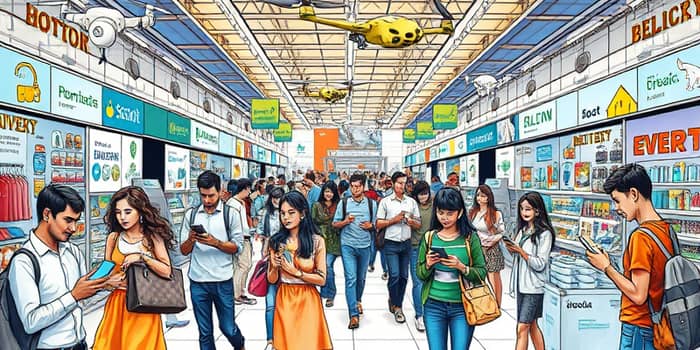As we approach the end of 2025, the global online retail landscape has transformed dramatically. From record-breaking sales figures to innovative technologies reshaping the customer journey, understanding these shifts is essential for businesses and consumers alike.
The State of E-commerce in 2025
Global e-commerce sales are now projected to reach $7.5 trillion this year, representing account for nearly a quarter of total retail revenue. An estimated 2.8–3 billion people shop online, and over 28 million e-commerce sites compete for attention. Knowing where you stand in this dynamic environment is the first step toward success.
These figures underscore the scale and breadth of modern e-commerce, emphasizing the need for agility and strategic planning.
Mobile-First: The Rise of M-commerce
Mobile commerce now commands up to 73% of online sales. With smartphones ubiquitous, businesses must adopt a mobile-first approach to retail—from lightning-fast pages to seamless wallet integrations. Push notifications and in-app messaging drive engagement, while instant checkout via digital wallets reduces friction and boosts conversion rates.
In the US, mobile retail sales alone are forecasted to hit $710 billion, making responsive design and high-speed performance non-negotiable.
AI, Personalization, and the New Digital Shopper
Artificial intelligence has become the engine powering personalization, fraud detection, and dynamic pricing. Over 60% of shoppers now expect tailored experiences, and businesses are responding: 92% utilize generative AI for customized product recommendations.
- Chatbots offering real-time assistance
- Recommendation engines boosting average order values
- Automated fraud detection safeguarding transactions
- Dynamic pricing algorithms optimizing margins
The AI market in e-commerce is set to reach $16 billion by year-end, illustrating the critical role these technologies play in competitive differentiation.
Marketplaces vs. Branded Stores: Where Are the Shoppers?
Online marketplaces drive 63.5% of total sales, with Amazon, eBay, and Walmart leading in the US. Yet branded stores remain vital for building customer loyalty and showcasing unique brand experiences. In the B2B realm, the market is valued at $32.1 trillion, growing at a 14.5% CAGR toward $61.9 trillion by 2030.
Top US retail sectors include:
- Fashion: 21.9% market share
- Electronics: 20.8%
- Hobby & Leisure: 20.3%
Meanwhile, secondhand and rental platforms flourish, driven by sustainability concerns and tighter budgets.
Social Shopping: The TikTok-ization of E-commerce
Social commerce is maturing rapidly. Today, 70% of consumers anticipate purchasing through social platforms by 2030, and already 7 in 10 have completed social-media transactions. Features like shoppable livestreams and embedded product tags turn every scroll into a potential sale.
Brands must integrate seamlessly with TikTok, Instagram, Facebook, and emerging apps, creating engaging, shoppable content funnels that resonate with digital-first audiences.
Sustainability, Resale, and the Circular Economy
Sustainability is no longer optional. One-third of shoppers abandon purchases over environmental concerns. Secondhand marketplaces and rental services are surging, as consumers seek greener and more cost-effective options.
Businesses can capitalize on this trend by offering certified pre-owned goods, eco-friendly packaging, and carbon-neutral shipping. These initiatives not only reduce waste but also build long-term brand trust and loyalty.
Logistics and Last-Mile: Meeting the Need for Speed
Fast, reliable delivery is a cornerstone of customer satisfaction. Yet 81% of shoppers abandon carts when preferred delivery options are missing. To win in 2025, retailers must partner with agile logistics providers, experiment with drones and autonomous vehicles, and expand local fulfillment networks.
Investing in green logistics—such as electric vehicles and consolidated shipping—addresses both speed and sustainability imperatives.
The Role of Retail Media and In-platform Advertising
Retailers are leveraging their own sites as advertising platforms, creating high-margin revenue streams. Retail media networks are forecasted to surpass television ad revenue by 2028, offering precision targeting based on purchase history.
By developing sophisticated ad products and analytics, merchants can monetize traffic while providing value to brands seeking direct access to ready-to-buy consumers.
Security, Trust, and the Future of Online Transactions
As fraud tactics become more sophisticated, robust security measures are indispensable. AI-driven fraud detection systems analyze patterns in real time, protecting both businesses and customers.
Implementing multi-factor authentication, secure payment gateways, and transparent privacy policies fosters unwavering customer confidence online—a critical factor in sustaining long-term growth.
Conclusion: Navigating Tomorrow’s Marketplace
For businesses and entrepreneurs, thriving in the evolving e-commerce landscape requires agility, innovation, and an unwavering focus on the customer. Prioritize a data-driven strategy for continuous improvement, experiment with emerging technologies, and embrace sustainability at every turn.
Ultimately, those who combine compelling brand experiences with seamless technology and ethical practices will lead the way. By staying informed, adaptable, and customer-centric, you can navigate the online marketplace with confidence and seize the opportunities of 2025 and beyond.
References
- https://cimulate.ai/resources/digital-commerce-statistics/
- https://www.sellerscommerce.com/blog/ecommerce-statistics/
- https://group.dhl.com/en/media-relations/press-releases/2025/dhl-e-commerce-trends-report-2025.html
- https://www.netguru.com/blog/ecommerce-statistics
- https://www.publicissapient.com/insights/future-ecommerce-trends
- https://explodingtopics.com/blog/ecommerce-stats
- https://www.webfx.com/marketplaces/statistics/
- https://www.statista.com/topics/871/online-shopping/
- https://www.forrester.com/report/2025-online-marketplace-tracker-global/RES182028
- https://www.mckinsey.com/industries/consumer-packaged-goods/our-insights/state-of-consumer
- https://www.clearlypayments.com/blog/how-many-online-stores-are-in-the-usa-in-2025/
- https://www.deloitte.com/us/en/insights/industry/technology/digital-media-trends-consumption-habits-survey/2025.html
- https://www.abtasty.com/blog/10-ecommerce-trends-for-2025/










